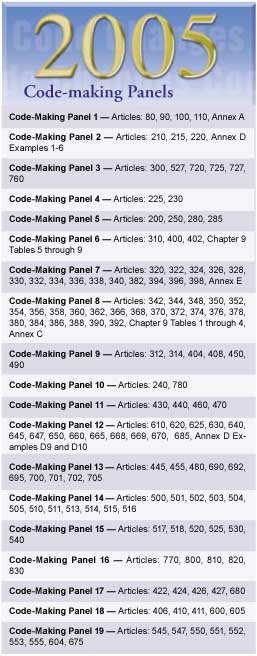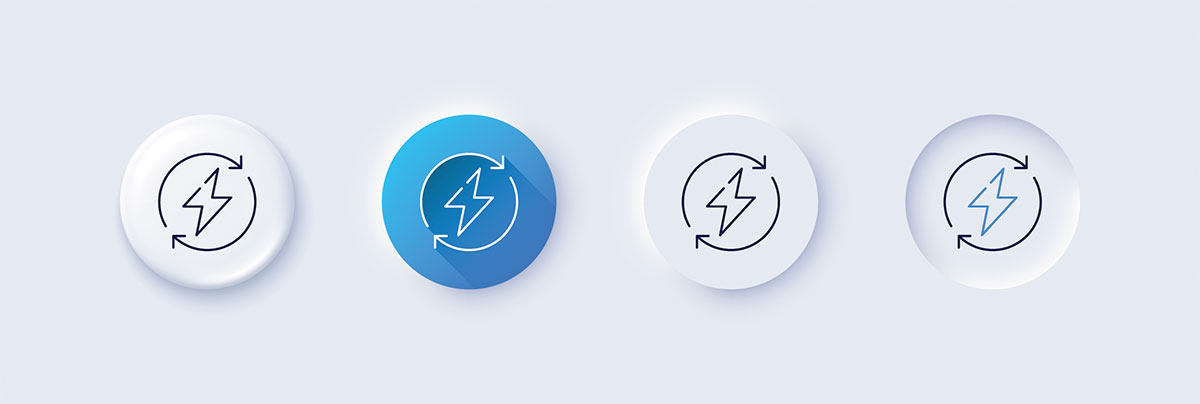It is that time of the Code cycle again. Over 3,580 proposed changes were submitted to the National Fire Protection Association (NFPA) to amend the 2002 National Electrical Code (NEC). The 2005 NFPA-70 committees have been reduced from twenty code-making panels (CMP) to nineteen as a result of shifts in responsibilities in an effort to more evenly distribute the workloads among the panels. Many of the code-making panel responsibilities have not changed. A summary of only those shifts in responsibility as a result of reducing from twenty to nineteen panels can be found here
These nineteen code-making panels met in January 2003 and took action on proposed changes to articles of the Code falling within the scope of the respective panel’s responsibility. This article provides a preview of the significant proposed changes and is the first of a two-part series to provide a brief summary of the actions accepted by the panels.
The NEC is amended on a three-year cycle and follows the ANSI- approved, NFPA open consensus process of developing codes and standards. The process is an opportunity for all to submit proposals and public comments. Proposal and comment forms are readily available for anyone who wishes to participate and everyone is encouraged to do so. The Report on Proposals (ROP) will be available for public review in July 2003. Code-making panels are required to act on proposals and comments submitted to them.
IAEI has assembled in this article a summary of some of the more significant proposals accepted by the panels in the first phase of the Code development process. This summary is not an indication that the Code is going to be revised as provided in this article, just that this is the initial action taken by the code-making panels, in the proposal stage of the process. Public comments and actions by the panels during the Report on Comments (ROC) meeting in December can have an impact on what has been accepted initially. Public comments to the proposed changes are strongly encouraged and needed for the best result. The IAEI is dedicated and committed to the NEC development process as evidenced by the participation in the panel hearings. IAEI seats a principal and an alternate representative on each CMP to represent the enforcement segment of the industry and provide the perspective of the electrical inspector.
In recent code cycles, significant emphasis has been placed on making the NEC a more user-friendly document. Some of the recent revisions that addressed the user-friendly issues include minimizing the use of fine print notes (FPNs) or eliminating them where possible, changing exceptions to positive text, and reorganizing and renumbering to provide a parallel numbering scheme between articles on the various wiring methods. The 2002 NEC experienced a major restructuring in Chapter 3 that incorporated many of the above-mentioned revisions and also included the relocation of articles covering equipment, such as switches and switchboards and panelboards to Chapter 4 of the Code, which was appropriate as these articles covered equipment rather than wiring methods or materials. Many involved in the day-to-day use of the Code saw these revisions as significant; and in many cases shocking, and they were resistant to these changes.
In the 2005 cycle a few more efforts were enacted that are intended to address usability issues. Guidance to the nineteen code-making panels was to address the term “listed for the purpose” where it appears throughout the Code. Basically, the panels have been directed to address this term and clarify what is actually required and, where possible, state what the purpose is. Another area addressed in the 2005 cycle is Article 220. The goal of the usability task group was to restructure and bring clarity to the provisions of Article 220, “Branch-Circuit, Feeder, and Service Calculations.” Two terms computed and calculated that were used in Code rules to mean essentially the same thing have been changed to calculated throughout for consistency throughout the NEC as well as to harmonize with the term calculated as used in other NFPA standards.
The following provides a brief summary of the proposed changes and includes the proposal number, the section, and a short description of how each of these sections was revised as a result of panel actions. This article is part one of a two-part series. Part two will follow in the September/October issue of the IAEI News
Article 90 Introduction
Proposal 1-25
New 90.2(B)(4) and (5) FPN
A new fine print note (FPN) has been added to this section to provide additional clarification and information as to what constitutes a “utility” as the word is used in this section. The information in the FPN explains in general terms that city, county, state, and federal government bodies regulate the installation, operation and maintenance of utilities. Utilities may also be subject to requirements and regulations by public service commissions or other regulatory agencies having jurisdiction. The FPN also indicates that utilities falling under such regulations are subject to meeting applicable codes and standards covering these installations or activities relevant to their industry as adopted under governmental law or regulation.
Proposal 1-45
Revision 90.9(C)(4)
The revision to this section clarifies when the soft conversion shall be used in Code rules where a negative impact on safety would result. The term “hard conversion shall not be required” has been revised from permissive language to the mandatory language “soft conversion shall be used” as incorporated in the revision. This should provide additional clarity and eliminate confusion that may have existed resulting from the current 2002 wording in the section. The soft conversion is considered a direct mathematical conversion and does not involve a change in the actual dimension as compared to the hard conversion, which is a change in dimension or properties of an item that might or might not be interchangeable with the original measurement.
Article 100 Definitions
Proposal 1-46
New Article 100 Definition of Abandoned Cable
This term was introduced into several articles in the 2002 cycle and also was included in rules to these various articles that require removal of abandoned cables. To meet NEC Style Manual requirements, the term has been defined in Article 100; and this definition is consistent with the definitions of abandoned cable in each individual article. The definition is consistent with the use of the term in the NEC.
Proposal 1-63
New Article 100 Definition of Bonding Jumper, System
The new definition is intended to clarify and differentiate between a main bonding jumper, which, by definition, is located at the service and a system bonding jumper, which essentially functions the same at separately derived systems. The current term used in 250.30(A)(1) is bonding jumper and will be replaced with system bonding jumper, thus requiring a definition for the new term. This change also will coordinate with other proposed changes made to existing grounding and bonding terminology used in Article 250 and other areas of the NEC.
Proposal 1-98
Revision Article 100 Definition of Grounding Electrode Conductor
The revision removes the term “from a common service” and adds the words “supplied by feeders or branch circuits” to the definition. The proposed change is not intended to impact current requirements of the definition, only to clarify that separate buildings or structures are generally supplied by feeder(s) or branch circuit(s) and are not necessarily always supplied from a common service. The changes proposed also promote consistency with the requirements of Article 225 and proposed revisions to Section 250.32 that remove the term “supplied from a common service” from that section.
Proposal 1-130
Revision Article 100 Definition of Qualified Person. Add new FPN
A new FPN has been added to the definition of qualified person to provide additional clarification and examples of what types of skills, knowledge, and training are necessary to meet the definition and true meaning of qualified person as it is used in numerous sections of the Code.
Article 110 Requirements for Electrical Installations
Proposal 1-172a
Revision 110.16 Flash Protection
This section was new for the 2002 NEC and has been revised to become more restrictive for the 2005. The revision will now require additional information that includes the incident energy levels(s) in calories per centimeter squared as well as the level of personal protective equipment and/or clothing required. The revision is safety driven and is intended to aid in proper selection of protective clothing or equipment where equipment must be worked on while energized. A new FPN has also been added to this section which provides a reference to IEEE Std. 1584-2002, IEEE Guide for Performing Arc-Flash Hazard Calculations to assist users of the Code on where to obtain necessary information to ensure compliance with this section.
Proposal 1-157
New 110.20 Enclosure Types
A new section was added here that parallels the provisions of 430.91, which includes enclosure information and a new table that provides the permitted uses for various types of electrical enclosures. The new section adds the requirements in text and tabular form just as is provided in Article 430. By inserting the information into Article 110, the enclosure requirements become a general requirement for electrical enclosures as referred to throughout the NEC and not limited to those covered by Article 430.
Article 200 Use and Identification of Grounded Conductors
Proposal 5-20
Revision 200.6(D)
This change reorganizes the section into a list format and clarifies the identification requirements for grounded conductors where grounded conductors of different systems are installed in the same enclosure or raceway. The revision clearly indicates methods by which these grounded conductors are permitted to be identified so as to be distinguished more readily from one another. The revision also incorporates the words “or gray” within this section to provide consistency with the color identification permitted by 200.6(A) and 200.6(B) and more directly correlates with those sections. A new sentence was added to indicate that the means of identification shall be permanently posted at each branch-circuit panelboard.
Article 210 Branch Circuits
Proposal 2-5
Revision Articles 210 and 220 – Revise the term guest room as used in these articles.
This revision resulted from a recommendation by the Technical Correlating Committee to clarify what is intended to be covered by the term guest room as the term is used in Articles 210 and 220. The term has been changed from guest room to guest rooms or suites, which clarifies that the requirements apply whether a single room is involved or a suite, which can include multiple rooms or a suite. A proposal for new definition of the term guest suite was accepted by Panel 1 which will correlate with the changes in terminology incorporated into Articles 210 and 220.
Proposal 2-70
Revision 210.8(B)(4)
This proposal was accepted in part to include additional requirements for GFCI protection for 15- and 20-ampere receptacles located outdoors and in public places in other than dwelling units. The new requirement is not intended to be applicable for those areas where the public does not have access.
Proposal 2-134a
Revision 210.12(B) and add a new exception
This section has been revised to indicate that a listed AFCI, combination-type device is required to be installed for protection of the entire branch circuit. A new exception has been added that will permit the location of the AFCI device to be where the branch circuit originates or, by exception, installed within 1.8 m (6 ft) of where the branch circuit originates. The conductors installed between the branch-circuit overcurrent device and the AFCI device for the length of up to 1.8 m (6 ft) must be installed in a metal raceway or cable with a metallic sheath to meet the provisions of the exception.
Article 220 Branch-Circuit, Feeder, and Service Calculations
Proposal 2-292
Revision Article 220 Branch-Circuits, Feeders, and Service Calculations
Article 220 was restructured and arranged to provide a more logical layout and address usability. The revisions were the result of efforts of a usability task group assigned by the Technical Correlating Committee. Additional proposals to revise Article 200 were appropriately incorporated into the acceptance of the proposal by the task group to restructure the article.
Proposal 2-298
New 220.3 Application of Other Articles
This change inserts language to reference other articles applying to calculations of loads in specific applications. They are provided in Table 220.3 that are in addition to, or modifications of, those requirements contained in Article 220. The table now includes a cross reference to the appropriate article and section to enhance usability.
Article 225 Outside Branch Circuits and Feeders
Proposal 4-9a
Revision 225.16 and 225.17
These sections have been renumbered as 225.16(A) and (B) and 225.17 was revised to add a reference to “masts” as a means of support to clarify that masts used as support means for overhead branch circuits or feeders are required to meet the same requirements presently found in 230.28 for service masts. The revisions to these sections provided consistency and uniformity between the support means and points of attachment for overhead branch circuits or feeders.
Proposal 4-25
Revision 225.30(A)(4)
The term standby systems was replaced with the term optional standby systems as directed by the TCC and is consistent with the language presently used in Article 702. Inserting the word “optional” provides reasonable assurances that the appropriate article will be applied based on the type of system installed in these locations.

Figure 1. Proposal 4-26a, revision 225.32, addresses inside and outside disconnecting means respectively
Proposal 4-26a
Revision – 225.32
The revision of this text combines Sections 225.31 and 225.32 for clarity and usability.
The requirements in former Section 225.32 were combined and organized into Sections 225.31(A)(1) and (2) covering inside and outside disconnecting means locations respectively. This section was also revised to add the wording “on or within sight from the building or structure supplied” to this section. Incorporating the term within sight from in this section relative to the required disconnecting means for separate buildings or structures provides reasonable clarity as to the permitted location of the disconnecting means where it might not be mounted directly on the building or structure. The term within sight from is defined in Article 100 as visible and not more than 15 m (50 ft) in distance from the building or structure (see figure 1).
Article 230 Services
Proposal 4-62
Revision 230.23(A) Change in terminology for consistency
This revision changes the word “computed” to the word “calculated” in this section as a result of the efforts of the NEC Usability Task Group to standardize the language used throughout the NEC. Essentially the two words had the same meaning in the Code rules where they appeared so the same word should be used for clarity. This revision in this section and the rest of the NEC where these words are used provides uniformity in the NEC and harmonizes with the same terms used in other NFPA Standards.
Proposal 4-77
Revision 230.44 Cable Trays
This section was revised to clarify that cable tray used to support “service-entrance conductors” is not permitted to support conductors other than service-entrance conductors. A new exception was added to clarify that cable trays provided with suitable barriers compatible with the tray are permitted to separate the service-entrance conductors from the other conductors supported by the same cable tray.

Figure 2. Proposal 4-86a is consistent with a similar proposed change to insert similar requirements in Article 225, which addresses outside feeder or branch-circuit disconnecting means
Proposal 4-84a
Revision 230.70
The revisions in 230.70(A) include renumbering the section to separate the inside location requirements from the outside location requirements. The words “on or within sight from the building or structure served” were added to new subdivision 230.70(A)(1)(a) which will permit the disconnect located outside the building or structure to be installed on the building or structure or located “within sight from” which, by definition, allows the disconnect to be remote but the building and service disconnect must be visible from one another and at a distance not to exceed 1.8 m (50 ft). This proposed change provides needed clarification to this section and is consistent with a similar proposed change to insert similar requirements in Article 225, which addresses outside feeder or branch-circuit disconnecting means locations (see figure 2).
Proposal 4-90
Revision 230.71(A)
This revision will now allow an additional disconnection means supplying a transient voltage surge suppressor (TVSS) to be exempt from the “six disconnects” requirement of 230.71(A) when the disconnect is installed as a part of listed equipment. Previous language did not recognize TVSS equipment as exempt from meeting the “six disconnects” rule. The requirement for the additional disconnecting means being part of listed equipment assures that the TVSS will be connected on the load side of the service disconnect as required by product standards and 285.21(A)(1).
Proposal 4-106
Revision 230.82(2)
The revisions to this section add “meter socket transfer switches” to the list of equipment permitted to be installed ahead of the service disconnecting means. The provision is applicable to equipment rated not in excess of 600 volts. The term meter disconnect switches was relocated to a new item (3) and minimum short-circuit current rating requirements for these types of meter socket disconnects was also added.

Sidebar. 2005 Code-making Panels













Find Us on Socials